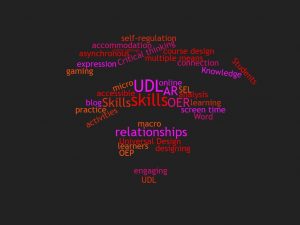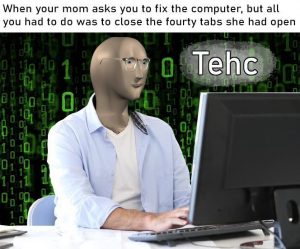It’s hard not to connect this coursework to what is going on in education today, and what it might look like over the next few years due to Covid-19, or any other emergency remote learning that might be necessary.

Some things that I will carry forward with me into my practice:
- This is my main focus in education, but its relevance is no different in this learning. Relationships are everything in learning. While this is already in practice for me, I have to consider the possibility of blended learning happening again, so I must focus on connections between students and myself and our classroom community. This focus on connection extends to my colleagues and professional development as well (see #3). The students that I work with already require support in building trusting relationships, for a variety of reasons, and with such a gap in their experiences with face-to-face school settings, I anticipate that this learning will be even more important in the next few years. No matter the technology or practices that our school or district mandates for use, I need to make sure that I am using my skills and knowledge to advocate for the students and their families to make sure that they don’t get left behind even further.
- I want to further consider and use of my understanding of Digital Citizenship in planning my activities. Many of the small group activities that I do with my students involve group games, discussions and activities that bring us together, mainly through play. I need to use my recreation skills and knowledge from this course to create activities that will work in an asynchronous way, and don’t just rely on our physical presence. This will ultimately benefit my students, as they aren’t always able to participate in activities when they are being presented, for many reasons (need for self-regulation, attendance, frustration tolerance, among others). These students thrive on mastery and independence, so building their self-reliance skills for independent learning and use of technology will be a focus for the upcoming fall, for sure.
- Lastly, at least for this blog’s purpose, I want to embrace and utilize connections between other professionals to support my own learning and practice. This process started naturally with the Covid closures (as mentioned in my previous presentation) with a group of colleagues connecting through email and other means. I want to look into further connections, and especially expand my learning outside of my immediate city and province.
I am becoming more aware of the variety of ways that I can utilize other technology within my district-prescribed-online classroom. I want to be thoughtful about what skills I have that are transferable to other technologies, and which skills I am sharing with my students (and colleagues) to build their digital citizenship. Most importantly, I want to bridge the gap between this learning and Social Emotional Learning. One thing I will share with my school going forward is to remember to focus on sharing within the learning communities. I feel like, face-to-face we do this naturally, by having students work together in groups or partners to complete a task, but this needs to be more purposefully done, particularly since there may be some asynchronous learning happening next year due to the ongoing pandemic.
One thing that could improve teaching with technology – the disconnection between people’s understanding of the negative impacts of “screen time” and the benefits of digital citizenship. Don’t want students to miss out on opportunities for connection and learning because of a limited understanding of the research.

When I consider screen time for my teenager – I don’t count those times when she is connecting with others, learning from others (watching videos about history, or watching the news) but rather use those as times to build her digital citizenship. When I think about screen time that I want to limit- that is simply video games, although I do think that her connection with others through gaming saved her life when she was most disconnected from her peers and caring adults at school.
Digital Citizenship and Literacy, as I understood it previously, referred to the students’ responsibilities when using technology provided at the school. Most notably, the agreement that they sign (or their parents sign) is a reminder to use technology appropriately for educational purposes. Technology that is provided must be used only for specific tasks or to support learning for students where it is indicated in their IPP. Still, being provided with a 1-1 iPad doesn’t necessarily provide a student with any accommodation for their learning without providing the skills and knowledge necessary to use it in any beneficial way. Students will easily understand how to play a game, but even choosing the right apps to load requires some forethought into the individual students, the purpose for its inclusion and what benefits it might provide for the student.
In our settings, students may bring their gadgets with the idea being that they are used to support their learning. Many students that I have worked with rely on their personal technology for self-regulation. Many have their phones filled with music or YouTube video playlists so that they can tune out triggers while they are working independently, or travelling to and from school. In elementary settings, personal devices are met with a different lens, and are generally expected to stay at home, or only be used during travel times to and from school, or as a reward for participating in activities. My biggest takeaway from my learning would be the depth and breadth of learning that makes up digital literacy and digital citizenship, and most particularly, the learning I took from “The Connected Teacher”.
References
Professor Alec Couros: “The Connected Teacher”—Youtube. (n.d.). Retrieved July 10, 2020, from https://www.youtube.com/watch?v=ru6LoU2-kC0&feature=youtu.be
Tehc. (n.d.). Retrieved July 12, 2020, from Know Your Meme website: https://knowyourmeme.com/memes/tehc


Hi Tammy,
I wholeheartedly agree with you about relationship at the heart of education. The importance of maintaining social relationships during this time has been so important, and I bring forward the social constructivism lens from our readings. it sounds as if this is a similar practice to yours.
I’m not sure abotu you, but I was certainly not expecting the dearth of changes and new skills that were required for how COVID 19 impacted the end of the school year. Looking into blended learning as a way ofbridging the needs of a socially diatanced classroom with meaningful learning.
I have enjoyed reading your posts and blog entries as a way of getting to kno you digitally over this semester. Thank you for sharing your wisdom and insights; I wish you all the best as we transition once again into an unknown school year.
May you and all beings be well,
Ren
Hi Tammy,
Thanks so much for your blog. It helped me reflect further on creating connections in the classroom and perceptions of digital literacy. During, this time I did use technology in the classroom try and keep the students connected. We did use learning games to connect, we had the students in the classroom connect with the students at home using online games and zoom. I have not tried playing games in an asynchronous way; however, due to you idea, I will look into it this summer.
In addition, due to your piece and this course, I can have a deeper conversation with parents when they say they do not want to have their child have a lot of screen time. As you stated, the negative impacts of screen time or the benefits of digital citizenship.
I also, have teenagers in the household and it was helpful for one of my daughters that she had a strong online relationship with a friend that had moved. They continued to talk daily and play games together online, this connection helped her in uncertain times.
All the references to connecting, reminding me of one of my favorite authors, Gordon Neufeld and attachment theory. We are trying to create connection through technology, which is similar to what happens in a classroom.
Thanks again and all the best in September, Monica
Tammy!
Great blog spot, very thoughtful and well said. I also believe strongly in social-emotional learning and feel as though it is the baseline for meaningful educational practices. It sounds like you’ve got positive and proactive intentions that will surely result in a holistic and well-rounded educational environment. Interesting point regarding personal technology as a means of self-regulation for students, as well as part of a reward cycle and even an easy escape route. The same as I carried my Walkman around all throughout high school.
All the best in the future!
Respectfully,
Jesse F Matthews
Hi Tammy
I agree that for your context, and broadly for primary education, the first vital task of a transition to online or blended is how you will develop or maintain connection with your students. I’m sure there will be a lot of possibilities to share once the first wave of these experiences can make it out into the blogosphere. I hope that there can be some solid research on this as well.
I agree with your thoughts about how naturally we manage social relationships in a face-to-face context. When we start to imagine how we can reach the same place in an online environment, it’s also an opportunity to think about the students who don’t naturally develop social relationships as easily, and whether there are online tools or designed online environments where they can thrive. I don’t think this is likely for all, but I have seen situations where very shy international students participated in online discussions much more than in person.
In thinking about using phones for self-regulation, I’m reminded that many programmers I knew at UVic had special play-lists to use while writing code.